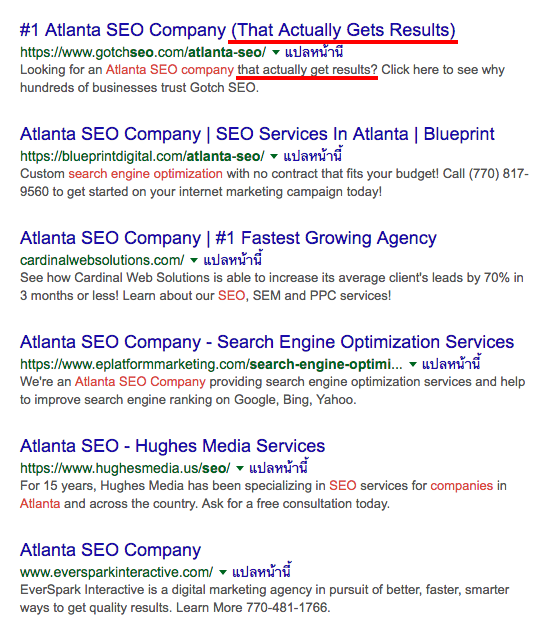Would you like to double the amount of organic search traffic your website receives each month, all without building a single link?
Most marketers associate more traffic with higher rankings — an understandable position when you consider that the top ranked Google organic search result has an average CTR of 31.24 per cent.
The second result, in comparison, draws in less than 15% of clicks. The third result, under 10% of clicks. The clickthrough rate for organic results continues to slide downwards as rankings get lower, with the 6th to 10th results earning a combined four per cent of clicks, on average.
A higher ranking almost always means more traffic, but not always. By optimising your listing’s meta description — the short snippet of information that Google shows to searchers — you can achieve the same clickthrough rate as the top organic result, all without being in first place.
From an SEO perspective, meta descriptions aren’t hugely important. From a clickthrough rate perspective, however, they’re massively important. The right meta description can double your clickthrough rate and help you get far more search traffic without any increase in your rankings.
All it takes to optimise your meta description is a little bit of creative thinking and knowledge of your audience’s needs. Add in some simple copywriting techniques and your meta description can transform your organic listing from a dud into a major asset that brings in far more traffic.
If you’re stuck in second place for an important keyword and want to generate the traffic you’d usually receive in first place, read on to learn more about how some tiny changes to your meta description can have a huge positive effect on the amount of traffic you receive.
Searchers assess relevance and newness using your meta description
Your page’s meta description has several jobs to perform. One of these jobs is to explain to your audience that your page is a relevant, up-to-date resource on its specific topic.
Pretend you’re a user searching for reviews of hotels in Paris. You’re looking for a helpful guide to the best hotels in Paris that’s up-to-date. You type “Paris hotel guide” into the search bar and see the following two results:
Which of these two results are you most likely to click on? Aside from some small differences in wording, the two listings are identical, except for one factor: the second listing has a note stating that it was last updated in March 2016 — the same month as your search.
In verticals like travel, being current means being more helpful. Hotels undergo renovations and change ownership, and what was a good hotel several years ago may no longer be a good hotel today. Between these two results, the most current one is the obvious choice for you to click.
If you sell a product that needs to be up to date, or deliver information that’s valued based on its newness, include the date your content was last updated in your meta description. You’ll notice a significant, measurable increase in traffic, especially if you rank in second or third place.
Searchers use your meta description to learn your value proposition
What value does your page offer to visitors? Better yet, what unique value does your page offer to visitors? Far too many search queries return results that are dominated by identical titles and meta descriptions, leaving the searcher with no idea of which result to click.
A great example of this is the results page for “Atlanta SEO companies”. Of the following results, most of which are almost identical, which one grabs your attention?
The first one, right? Unlike the others, which are optimised only for Google’s algorithm, the first result is written with a clear value proposition: results. The value proposition is used twice in the listing — once in the title, and again in the meta description.
This type of meta description optimisation has a huge impact on your organic CTR because it helps your business stand out from its competitors. You’re no longer just one of many options for a certain search keyword — you’re the only option that delivers a specific form of value.
Since you only get 60 characters for your title, the best place to mention your value proposition is your meta description. In a minute, you’ll learn a simple formula for writing a meta description that shows users your value proposition and encourages them to take action.
Searchers view your listing like an ad, so write it like one
According to research by Bunnyfoot, 40% of Google search users are unaware of the difference between AdWords ads and organic search results.
This means that many of the people searching for your website respond to it the same way they would a paid AdWords ad. There’s little distinction to most users, so why isn’t your listing written like a short, punchy and effective AdWords ad?
Many marketers optimise their listings for Google’s algorithm, including keyword after keyword to increase relevance. At the same time, they ignore the importance of copywriting that’s often difference between a profitable and unprofitable AdWords campaign.
In our post on optimising for organic search CTR, I shared a simple formula that you can use to write relevant, CTR optimised listings. Here it is again:
- Inform users about what to expect after they reach your page
- Mention a benefit, preferably one that’s unique to your listing
- Finish with a call to action that makes users want to click
The first part of this is simple. All you need to do is describe your website’s content so that users know what to expect after they click. The second part is also easy — mention your unique selling point or your value proposition.
Finally, close with a clear call to action that tells the user exactly what they should do next, after reaching your page. Our call to action tells users to request a free consultation. Yours could tell them to click through to your page, to call you, to request a free sample or anything else.
The key to this process is to treat your organic listing like an AdWords ad, since that’s how most users will see it. Make sure each character in your listing serves a purpose, whether it’s to teach users about your page’s content, mention your value proposition or tell them to take action.
In short, use text carefully. It’s easy to optimise your meta description for Google, only to forget that its main purpose is to make your listing appealing for searchers.
Meta descriptions matter. How good are yours?
It’s easy to drop the ball on meta descriptions, since many SEOs view them as an unimportant ranking factor. While meta descriptions might not be that important from a ranking perspective, they’re hugely important when it comes to optimising for clickthrough rate and conversions.
A great meta description can double your clickthrough rate, helping you generate more traffic in second place than the website outranking you in first. This extra traffic means more leads, more sales and more revenue for your business, even without an improvement in its organic position.
How good are your meta descriptions? Using the simple three-step formula above, go over your meta descriptions and make sure they’re as optimised as they could be. A few small changes to your copy could help you achieve record-setting traffic (and revenue) next month.




 (
( (
(
 Like us on Facebook
Like us on Facebook
 Follow us on Twitter
Follow us on Twitter
 Connect on LinkedIn
Connect on LinkedIn